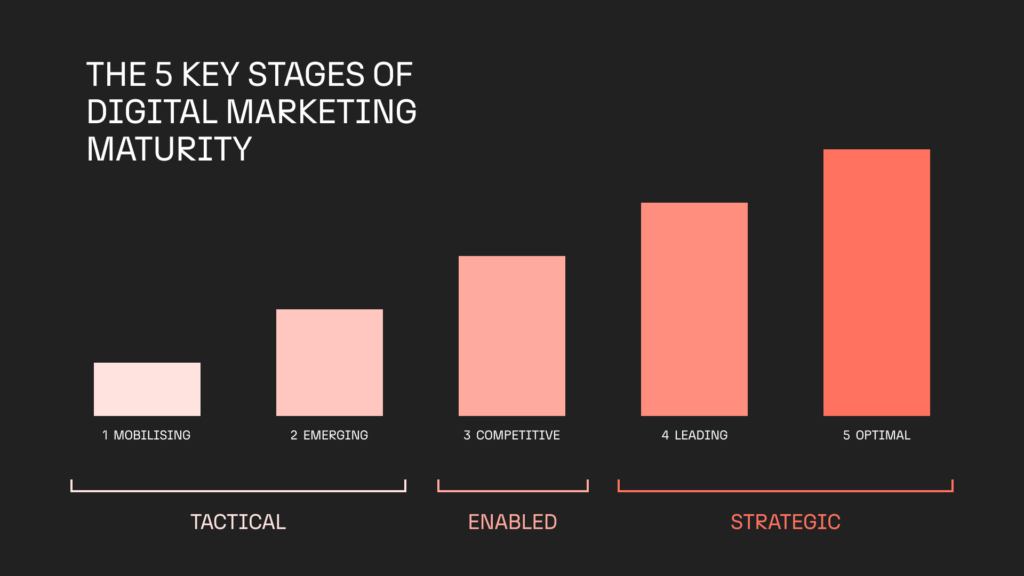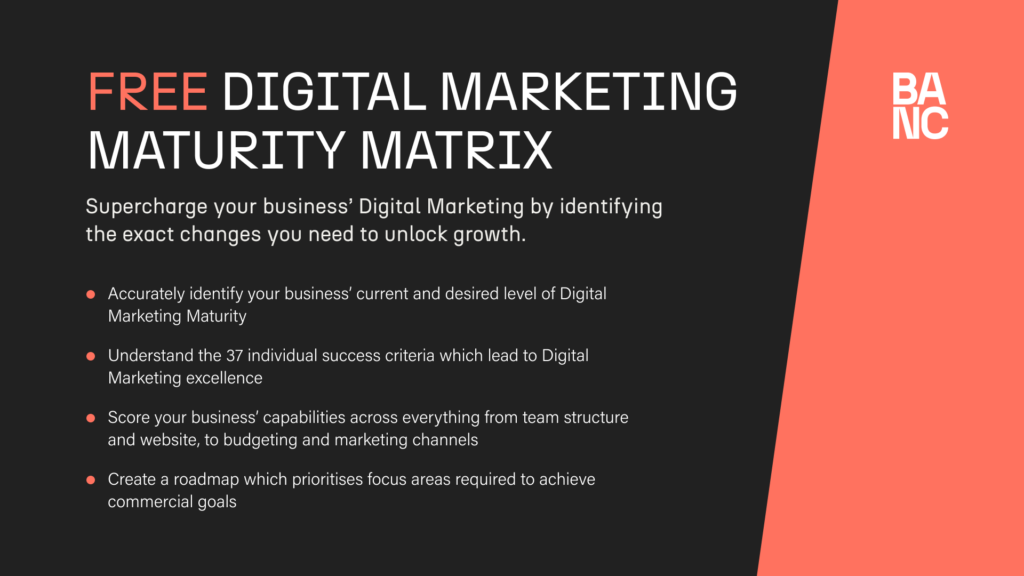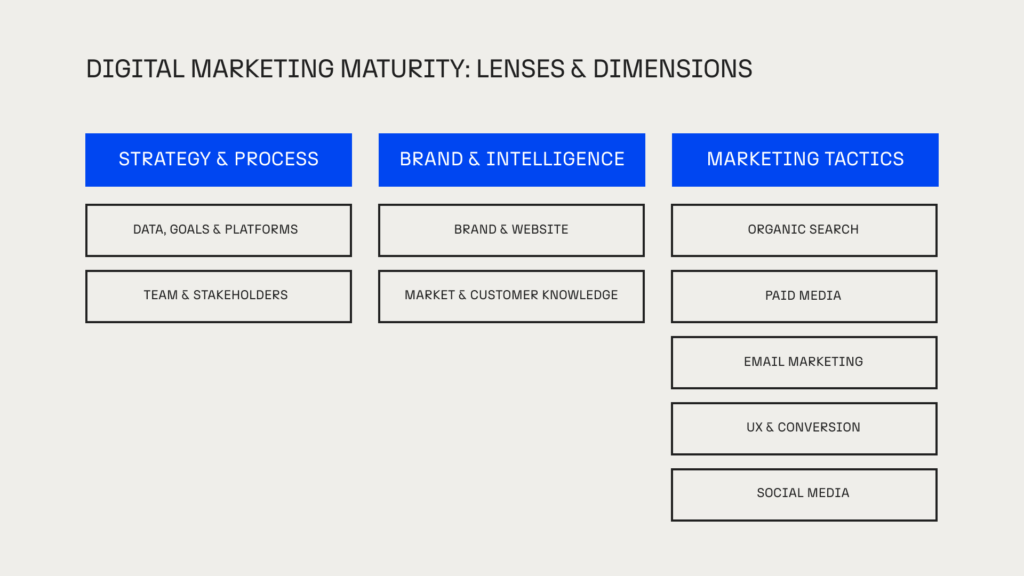The 5 Stages of Digital Marketing Maturity [with Self-Assessment & Matrix Template]
Digital Marketing can be a complex beast. With so many tools, tactics, touchpoints and metrics available, it’s difficult – even for seasoned leadership teams – to know how to deliver success against company objectives and KPIs that relate to the organisation’s outlook.
To calm things down a little, we’ve drawn on our experience working with over 110 clients across BANC’s history, to create a methodology that’ll help you boost your strategic and operational skills within Digital Marketing – so you can unlock that commercial growth.
The result is our Digital Marketing Maturity Matrix. In this guide, we’ll walk you through the key tenets of our model, so you can understand:
- Your business’ current and desired level of Digital Marketing maturity
- The areas of transformation your business should prioritise to reach its goals
- The individual interventions and changes so you can reach those desired outcomes
In this resource, you’ll also find a self-assessment tool to quickly gauge your business’ current maturity stage, as well as a downloadable maturity matrix template to help you score your business’ capabilities and track progress through the Digital Marketing maturity curve.
What is digital marketing maturity?
Maturity models aren’t anything new. Usually found in the domain of management consultants, they’re a framework for measuring an organisation’s abilities within a particular area, along with the interventions needed to make high-quality improvements.
Maturity models assess people, processes, technology, the leadership view, investment and operational tactics. Ours does the same – just across the entire Digital Marketing spectrum.
WHY MATURITY MODELLING MATTERS
Every business has their own individual strengths and weaknesses. Because of this, not every business will need a peak level of Digital Marketing maturity to achieve success.
The value in our model comes from creating a clear roadmap for activity, investment and change – signposting which improvements should be made and when. Because of this, it prioritises strong foundations, achieving maximum performance from Digital Marketing activity as your business scales.
A managed and measured approach like this is crucial. Rushing to graduate towards higher levels of activity in certain areas, without a strong base of operational maturity can create confusion and hinders your business’ ability to capitalise on strong performance.
Our tool takes a holistic view of channel activity so your activities are coordinated in line with the business’ ultimate strategic view.

THE 5 STAGES OF DIGITAL MARKETING MATURITY
With 15 years’ experience of guiding organisations from a range of industries through the Digital Marketing growth curve, we’ve identified and categorised the features and attributes these organisations tend to exhibit at different levels of maturity.
In our model, we refer to these as Key Maturity Stages.
These are:
- Mobilising – The beginning of a business’ Digital Marketing transformation journey. There’s a degree of activity, but objectives, channels, tools and data haven’t been defined yet.
- Emerging – The business has some strong Digital Marketing foundations in place and is starting to build out tactical goals and activity so they can work towards key areas of change.
- Competitive – With their Digital Marketing making a name for themselves in the market, the business’ channel activity is more joined up in ways that let them achieve their goals. This approach connects Digital to broader commercial strategy and turns investment to growth at a much quicker pace.
- Leading – With strong performance and an integrated strategy aligned with organisational goals and commercial modelling, the business is growing in the market. And to make sure it keeps growing, it refines activity and systems, and introduces new interventions too.
- Optimal – Digital Marketing is a core feature of the business’ growth strategy and is aligned with commercial strategy at a high level. From a Digital Marketing perspective, it’s a real industry leader – the kind which competitors aspire to.
SELF-ASSESSMENT QUIZ: REVEAL YOUR BUSINESS’ MATURITY
Naturally, there are a range of interventions across the leadership view, process, people, systems, tools, investment, channel activity and data required to move effectively through these stages. All of that, of course, requires a lot in the way of effort.
But before we dive into these in greater detail, we’ve created an initial self-assessment tool so you can weigh up your business’ current level of Digital Marketing Maturity.
Getting the most from this guide is a simple case of answering the questions in the quiz below to understand where your organisation currently fits – then using the rest of the guide to help understand what your future roadmap should look like.
1. MOBILISING
This stage represents the very beginning of the Digital Marketing Transformation journey. At this level, businesses are typically SMEs in in a trade or network marketing environment – and are seeing increased costs and lower returns from traditional sales and marketing.
Certain colleagues within the business are interested in Digital’s potential, but it’s yet to form part of the leadership team’s agenda.
Still, some ad-hoc tactics are in place, but there’s no link to overall marketing or business objectives – platforms, channels and management information are a long way away from being established.
| Strategy | Activity has not yet reached the scale where a link to strategy or business objectives is feasible. |
|---|---|
| Process | Some work is undertaken based on anecdotal information. Processes are undefined, and efforts are project-based. |
| Leadership | The Leadership team is broadly unaware of tactics being trialled. |
| Investment | ‘Test’ budgets are given to one-off projects, with no dedicated investment plans. |
| Activity | Some ad-hoc activity is being tested, predominantly on a single channel (likely Paid Search). The focus is on the channel itself rather than business results. |
| Platforms | A basic ‘brochure’ website explains the business’ products and services. The website has a contact form but few ways to interact/transact. |
| Management Information | Some informal data is available from test projects, but this offers no utility for management decision-making. |
| People | There is no dedicated resource for Digital Marketing activities; colleagues ‘pitch in’ from other marketing roles and functions. |
2. Emerging
Like all elements of change and transformation, Digital Marketing Maturity isn’t always a straight line – and a maturity model quantifying this lifecycle needs to reflect this.
In fact, the most rapid and interruptive change happens between Stage 2 (Emerging) and Stage 3 (Competitive). Think of this as businesses ‘grasping the nettle’, and having to make foundational interventions.
Within the Emerging stage, the value of Digital Marketing is still likely being ‘pushed’ to the business. This can bring some painful reassessment and uncertainty before the future picture becomes clear.
For this reason, we’ve broken down Stage 2 into more granular detail to highlight what businesses can typically expect as they move through these flashpoints.
2a. Recognise & Test
Within this sub-stage, some more activity is happening – thought its restricted by test budgets. The business is also starting to capture some data from its Digital Marketing efforts, but there’s no broader model to connect it to. On the plus side, knowledge is increasing, and internal colleagues are starting to recognise gaps that further possibilities can fill.
2b. Believe & Commit
By this sub-stage, activity has been running for a significant time and results have been used to identify new opportunities. The business has likely tried some of the right things, but in the wrong order – to start firing on all cylinders they’ll have to make more changes.
Rudimentary processes are beginning to form, and the leadership team is starting to become engaged. The business is open to the idea if it can prove value – ‘show me the cost’ and ‘if we see it working, we’ll invest more’ are the prevailing attitude.
2c. Yet to Deliver
The organisation takes things more seriously in this sub-stage, but Digital Marketing still hasn’t demonstrated real business value. Resources are being recruited and ideas around goals, data, tools and processes are starting to form, though internal friction is likely experienced.
By this point, the business is preparing for the future and starting to build an environment where strategy and optimisation become possible.
| Strategy | 2a. | Some more activity is happening in isolation of the business’ commercial strategy. |
|---|---|---|
| 2b. | The potential of Digital Marketing is starting to be explored within the business’ mix. | |
| 2c. | Digital Marketing is becoming a go-to-market lever; the environment for connecting to strategy is starting to form. | |
| Process | 2a. | The approach is fragmented and informal – there is some planning in siloes. |
| 2b. | The need for processes is understood, and the focus is on codifying and formalising. | |
| 2c. | Core ways of working are established, with additional processes in development. | |
| Leadership | 2a. | The leadership team is aware of activity, but exhibits low visibility and belief. |
| 2b. | The leadership team is in the process of learning and buying into Digital Marketing. | |
| 2c. | Leaders adopt an open mindset around future opportunities – belief to do more is secured. | |
| Investment | 2a. | The investment footprint is starting to increase, with hopes to see results. |
| 2b. | Plans are being made to allocate budgets for Digital Marketing. | |
| 2c. | A dedicated budget for Digital Marketing has now been allocated. | |
| Activity | 2a. | Reactive activity is happening across a limited set of marketing channels. |
| 2b. | There is ambition to undertake more activity (likely Organic Search and Paid Social) – new options are explored. | |
| 2c. | Multiple channels are being used in a siloed way. Tactical plans improve following validation. | |
| Platforms | 2a. | Potential for the website as a tool to transact or acquire leads is being discussed. |
| 2b. | The website is in the process of being refreshed to become marketing-ready. | |
| 2c. | The website has been relaunched to become transactional – simple conversion points act as ultimate marketing goals. | |
| Management Information | 2a. | Proper tools for data collection are not yet in place. Measurement is anecdotal. |
| 2b. | Decisions are made around what to measure and collect; tools are being implemented. | |
| 2c. | Data is being collected in a managed way, but not fully analysed. Connection to business impact remains unclear. | |
| People | 2a. | Roles are undefined, and responsibilities shared across colleagues. |
| 2b. | A dedicated resource for Digital Marketing is being explored. | |
| 2c. | A junior Digital Marketing resource is recruited. |
3. Competitive
With the tactical foundations in place, Stage 3 (Competitive) happens when organisations start bridging their Digital Marketing activities to strategy, and aligning these with company goals.
By this stage, stakeholders across the business possess an active interest – there’s a desire within the business, rather than the agenda, driving the move towards it.
Much like with the prior stage, the Competitive stage can be broken down into two sub-stages.
3a. Reaching for Levers
With the correct internal resource in place, processes formalised, and a range of activity happening all at the same time, the focus shifts from medium-term channel performance to a longer-term view.
The business will start to explore advanced tactics, recognising the requirement for CRM, and pursuing interest in the continuous improvement of the website and UX/Conversion tactics.
3b. Connecting to Strategy
By the end of this stage, marketing data will be collated into a single ‘source of truth’ and help drive some decisions; dashboards will be used to communicate with other functions and senior stakeholders, and different attribution models will consider value at multiple touchpoints.
By this point, the business will have a meaningful marketing presence in its market. Its in a place to join up the dots and make Digital Marketing a core feature of its growth plan. External support is typically sought for strategy and delivery to make this happen.
| Strategy | 3a. | The approach is transactional and tactical, but with a desire to connect to strategy. |
|---|---|---|
| 3b. | Digital Marketing is being formalised within strategy, and modelled in commercials. | |
| Process | 3a. | Ways of working are routinely adhered to, with understanding across teams. |
| 3b. | Processes are fully owned, documented and regularly reviewed. | |
| Leadership | 3a. | Company sales and marketing objectives include Digital as a key feature. |
| 3b. | The Board is involved in Digital Strategy, cementing a 3-5 year growth plan. | |
| Investment | 3a. | Budgets are increasing to support a larger remit of tactical activity. |
| 3b. | There is a strategic investment view on Digital – planning for the future picture. | |
| Activity | 3a. | A range of activity is happening across channels, the need to align is recognised. |
| 3b. | Fine tuning is happening – advanced tactics and more mature reporting (CPA, attribution models) are utilised, but not yet optimised. | |
| Platforms | 3a. | Website functionality is expanded to support other touchpoints and features – content functionality, lead capture points, and other page types. |
| 3b. | A CRM is integrated with the website and sales & marketing channels – basic configuration allows visibility on status of customer records. | |
| Management Information | 3a. | Data from digital marketing has become reliable and measurable – the business is figuring out the connection to growth. |
| 3b. | Marketing data is now actionable – decisions are made with commercial impact in mind. | |
| People | 3a. | A Digital Marketing Manager is in place, and small individual contractors are utilised. |
| 3b. | The business is seeking external expertise for both strategy and delivery. |
4. Leading
At Stage 4 (Leading), Digital Marketing is finally integrated with the business revenue and ‘big picture’ commercial modelling. The organisation takes a strategic, longer-term view of value – with performance management and forecasting data guiding future decision-making.
Processes are fully owned and documented, and a more mature dedicated team is in place, utilising external support.
The business utilises multiple marketing channels in a sophisticated, scalable way, part of a single strategy working to KPIs aligned across all activity. Digital Marketing’s remit now extends to the entire customer lifecycle beyond acquisition – with loyalty, retention and lifetime value becoming priorities. Regular adjustments are made using a range of internal and external insights.
A broader measurement framework is in place – conversions are tracked back to business value through the whole piece and understood against the bottom line. The business is working towards overall customer acquisition costs for Digital Marketing as a whole and makes constant refinements.
| Strategy | A long-term strategic roadmap is established, connected to‘big picture’ revenue goals and commercials. Digital Marketing permeates customer lifecycles beyond acquisition. |
|---|---|
| Process | Processes are ‘owned’ and well-documented. They are shared and continuously updated to reflect goals and requirements. |
| Leadership | Leaders have bought into the value of Digital Marketing in the organisation’s growth agenda; high-level company objectives cascade into a long-term marketing and advertising view. |
| Investment | ‘Negotiated’ budgeting aligns marketing activity with commercial planning – necessary costs are tied to goals and targets set by the leadership team. |
| Activity | Channels are integrated to form a holistic strategy. The role of each discipline in driving new customers is fully understood through feedback loops. Customer acquisition costs are attempted, and CPAs are adjusted per channel. |
| Platforms | The website is fully integrated with back-office and IT systems (i.e. CRM, ERP) — providing a seamless connection between its customer-facing presence and business operations. Continuous learning and improvement is a priority. |
| Management Information | Key data is connected to the business analytics suite, and is utilised for performance management and forecasting. Data is highly actionable and routinely used to guide strategy decisions with commercial impact in mind. |
| People | A senior Digital Marketing lead manages a more specialised team, and utilises external support for both strategy and delivery. |
5. Optimal
Finally, Stage 5 (Optimal) represents true Digital Marketing excellence across key features of the business’ operations. It’s firmly the realm of large enterprise, requiring significant investment into technology, people and business infrastructure.
At this point, the business has firmly established itself as a market leader in terms of Digital Marketing – it’s viewed as a touchstone by competitors in its industry, and sets the bar for quality across the sector.
Digital Marketing is a core feature of the business’ growth strategy and is aligned with commercial strategy at a high level.
In brief, it looks like this…
| Strategy | A long-term, co-ordinated perspective on company strategy is communicated by the executive team. A CMO works with executive peers to ensure this is translated to Digital Marketing, devolving execution responsibility. |
|---|---|
| Process | Digital Marketing processes are proactively managed with a focus on continuous improvement. Core ways of working are understood across all areas of the organisation to enable collaboration between teams, suppliers and stakeholders. |
| Leadership | The senior Digital Marketing lead works closely with a CMO and other stakeholders to ensure a strong understanding of the business strategy and market position, translating this into operational plans aligned with high-level objectives. |
| Investment | The business operates an element of dynamic budget planning within its FP&A process, where additional investment can be unlocked based on emerging commercial opportunities — and driven by data, forecasting and value assessment. |
| Activity | Activity now operates at a scale where small adjustments and optimisations can significantly impact revenue. Testing and analysis are an organisational asset, and the focus is on fine tuning, scalability and cost-efficiency. |
| Platforms | The website is a primary method for customer interaction and intelligence. CRM is the lynchpin of a business-wide customer lifecycle. If relevant, an enterprise Ecommerce solution is tailored to business requirements. Personalisation, automation and AI deliver industry-leading experiences. |
| Management Information | Digital Marketing is aligned to the business’ revenue and cost of sale targets, based on EBIT/DA. Accurate customer acquisition costs, sophisticated attribution and AI modelling inform decisions for ATL, brand and performance channels. |
| People | A highly skilled team with multiple units work across defined channels and activity, utilising external support in key areas. A mature management structure maintains alignment with company objectives. |
Free Template: Digital Marketing Maturity Matrix
Having discussed the key features at the main stages of Digital Marketing maturity, some of the above might sound familiar.
It’s useful to have a high-level understanding of these Key Maturity Stages – but what about the exact new steps required to improve?
Our model utilises 3 core Lenses through which to assess your business’ current capabilities (each with multiple detailed Dimensions within them) – these make up the 37 individual success criteria which contribute to your Digital Marketing excellence.
We’ve created a downloadable template below to see how your organisation scores across these criteria – covering everything from Data and Platforms to Market and Customer Knowledge; from Team and Stakeholders to operational readiness of each key Marketing Channel.
Your scoring will then map closely to each Key Maturity Stage, which you’ll be able to fine tune based on your detailed Dimensions scoring – providing tangible and actionable priorities to inform your Digital Marketing Strategy with.

Simply fill out the form below to access your free downloadable template:
Diving Deeper Into Specifics
As you’ll see in the above tool, our Digital Marketing Maturity Matrix (DiMM) maps findings across 37 different maturity signals, organised into 9 ‘Dimensions’ (or topics) under three major Lenses (or categories).
Each criteria is scored 1-5 and offers a holistic view of different capabilities in line with business strategy and ambitions.
These Lenses and Dimensions are:

- Strategy & Process: How well-equipped the business is to deliver Digital Marketing excellence from knowledge, strategy and operational perspectives.
- Brand & Intelligence: How well the business understands its target audience, market outlook and positioning — and how effective its brand identity is as a vehicle for marketing and advertising delivery.
- Marketing Tactics: Which marketing and advertising delivery channels are being utilised — and to what level of maturity and success.
Some of the information required to plot your business on the matrix may come easily, but other insight might need some internal foraging – whether it’s conducting deep dives with business and marketing stakeholders, or utilising control questionnaires to understand the current level of competency across your marketing teams.
By the time you’ve completed the template, you’ll have the basis of a high-level management report and the recommendations to drive your business’ Digital Marketing agenda forward, as well as a series of prioritised changes which should form the basis of your strategic roadmap.
Book a Discovery Session
We hope you’ve found this resource and the tools within it useful. No matter where your business is on its Digital Marketing Transformation journey, our Strategy team is ready to help you grow. Book an initial discovery session here to discover how we can get you towards your goals.



